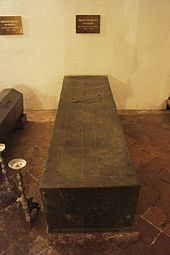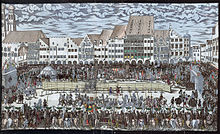Wilhelm V (Bavaria)


Wilhelm V the Pious (born September 29, 1548 in Landshut ; † February 7, 1626 in Schleissheim ) was Duke of Bavaria from October 24, 1579 until his abdication on October 15, 1597 . His rule was just as significant for the development of the art of Mannerism in Bavaria as it was for the success of the Counter-Reformation in Germany. The glockenspiel at Munich City Hall still reminds of his splendid wedding in 1568 , and the epoch-making Michaelskirche and the Hofbräuhaus also go back to Wilhelm.
Before taking office
Wilhelm was born as the second son of Albrecht V during his prince's time at Trausnitz Castle above Landshut , an old center of power of the Wittelsbachers . His mother was Anne of Austria , daughter of Emperor Ferdinand I . In 1568 he married Renata of Lorraine . The wedding was celebrated with great effort in his father's residence in Munich and is documented in detail in contemporary texts and images.
The prince couple then set up court at Trausnitz Castle, where significant artistic efforts were made. Renata von Lothringen was a daughter of Christina of Denmark and a niece of Emperor Charles V and grew up at the Lorraine ducal court. Above all, she brought knowledge of French and Spanish court culture to Landshut. Wilhelm, in turn, was closely related to the Habsburgs , but also to the Medici , so that the artistic centers of Innsbruck, Ambras, Vienna and Florence also developed role models. The prince couple received important suggestions from Wilhelm's uncle Archduke Ferdinand of Tyrol , who from 1567, as sovereign, expanded the residence in Innsbruck with gardens and pleasure palaces (e.g. Ruhelust Castle) and from 1572 set up a famous art collection in Ambras Castle. Hans Fugger in Augsburg also became a close advisor, not only providing him with ideas and personal contacts, but also providing large loan amounts together with others.
In Landshut, the fortified Trausnitz Castle was structurally expanded and painted with extensive picture cycles. In the valley, a park in the style of a Renaissance garden based on French models was created in front of the city walls, and on the mountain around the Trausnitz an extensive zoo with many exotic and rare animal species. From 1573 onwards, the work was coordinated in an artistic sense by the Dutch painter Friedrich Sustris , who was trained in Florence , who in the new post of art director put the various types of art in the service of princely self-staging and was also to exercise this function in Munich.
Reign
After the death of his father, Wilhelm V took over the government in the Duchy of Bavaria in 1579 and moved with his wife to the residence in Munich .
After taking office, Wilhelm V continued his father's counter-Reformation policy. In 1583 he sealed a concordat in Munich , which regulated the extended powers of the sovereign in church matters. In the same year he intervened in the Electoral Cologne War after the Archbishop of Cologne Gebhard Truchsess von Waldburg converted to Protestantism. He supported the conquest of the archbishopric by his brother Ernst financially and with his own troops, which increased the Bavarian debt mountain by a further 700,000 guilders. As a result, the Wittelsbachers provided the Cologne elector and archbishop until 1761. After the conflict over Cologne, Wilhelm wanted to replace the originally non-denominational Landsberger Bund with a purely Catholic alliance, but at that time this failed because of Austria and Tyrol.
Like his father lavishly, he promoted the arts and the Catholic Church. He built the Jesuit monastery in Munich and, from 1583, the Michaelskirche, the largest Renaissance church north of the Alps. Under Wilhelm V the Jesuits also came to Altötting , Regensburg , Biburg , Münchsmünster and Ebersberg . Munich became a center of sculpture that was shaped by Hubert Gerhard and Hans Krumpper . Hans von Aachen and Peter Candid , among others, worked as painters at his court . Orlando di Lasso worked at the Munich court orchestra .
In 1588 Wilhelm compared himself with his brother Ferdinand , who had entered into a morganatic marriage, and ceded the county of Haag to him, which Emperor Rudolf II confirmed in the following year .
Around 1590 Wilhelm V appointed the committed canon Adolph Wolff von Metternich (1553–1619) from Speyer as court master of his sons Philipp and Ferdinand, who were destined for the clergy . In 1592 and 1593 he stayed with them in Rome, where they studied. In 1591 Wilhelm drove the Salzburg residents out of the prince-provostie Berchtesgaden , the future property of his son Ferdinand, after an attempt at annexation .
As early as 1577, the estates that were responsible for approving taxes for the duke were no longer convened regularly. Wilhelm increasingly suffered from the demands of ruling his financially ailing duchy and fled into asceticism . As a cost-saving measure, he had the first court brewery set up in 1589 , as the beer caused considerable costs for the Munich court, especially when it was imported, e.g. B. from the distant Einbeck . In 1591 Wilhelm V had the Italian “gold maker” Marco Bragadino executed in Munich for “fraud and sorcery”. He had promised the Duke, who was now in constant financial difficulties, that he could make gold out of lead. At the same time there was an increase in the persecution of witches with cruel executions. Since 1594 there was a ducal salt monopoly. In 1596 the Duke founded a pheasant farm between Moosach and Feldmoching in the area of today's Fasanerie-Nord . Despite all the measures, however, it was not possible to reorganize the state finances.
Abdication and Late Years
From 1594 Wilhelm gradually involved his eldest son Maximilian in government affairs, on October 15, 1597 he abdicated and on February 4, 1598 he released his officials and subjects from the oath of loyalty. He himself kept an annual tapping of 60,000 guilders and retired with his wife to the newly built Wilhelminische Veste . From 1598 he had a simple mansion built outside of Munich, from which the Schleißheim Palace complex developed. In 1602 his wife Renata died. Despite the high appanage, Wilhelm lived very modestly and withdrawn in religious contemplation and founded an orphanage and an infirmary, among other things. A monastery consecrated to St. Karl Borromeo was also founded in 1623 by the abdicated duke and initially housed Basilians . Wilhelm did not die in Schleissheim until 1626.
Marriage and offspring
Duke Wilhelm V married on February 22, 1568 in Munich Renata von Lothringen (1544-1602), the daughter of Duke Franz I of Lorraine and his wife Princess Christina of Denmark . The wedding was celebrated with an unusually large effort for 18 days, the festival music was composed especially by Orlando di Lasso. The marriage had ten children:
- Christoph (* / † 1570)
- Christine (1571-1580)
- Maximilian I (1573-1651)
- ⚭ 1595 Princess Elisabeth Renata of Lorraine (1574–1635)
- ⚭ 1635 Princess Maria Anna of Austria (1610–1665)
- Maria Anna (1574–1616) ⚭ 1600 Archduke Ferdinand II of Austria, later Emperor
- Philipp Wilhelm (1576–1598), cardinal deacon and prince-bishop of Regensburg
- Ferdinand (1577–1650), Elector of Cologne, Prince-Bishop of Liège, Münster, Hildesheim and Paderborn
- Eleonore Magdalena (1578–1579)
- Karl (1580–1587)
- Albrecht VI. the Leuchtenberger (1584–1666) ⚭ 1612 Princess Mechthild von Leuchtenberg (1588–1634)
- Magdalene (1587–1628) ⚭ 1613 Duke Wolfgang Wilhelm von Neuburg
family tree
|
Albert the Wise Duke of Bavaria |
Kunigunde of Austria |
Philip I Margrave of Baden |
Elisabeth of the Palatinate |
Philip the Fair King of Castile and León |
Johanna the madwoman |
Vladislav II. King of Bohemia and Hungary |
Anne de Foix-Candale | ||||||||||||||||||||||||||||||||||||||||||||||||||||||
|
Wilhelm IV Duke of Bavaria |
Maria Jakobäa of Baden |
Ferdinand I. Roman-German Emperor |
Anna of Bohemia and Hungary | ||||||||||||||||||||||||||||||||||||||||||||||||||||||||||
|
Albrecht V Duke of Bavaria |
Anna of Austria | ||||||||||||||||||||||||||||||||||||||||||||||||||||||||||||
| Wilhelm the Pious | |||||||||||||||||||||||||||||||||||||||||||||||||||||||||||||
literature
- Berndt Ph. Baader: The Bavarian Renaissance courtyard of Duke Wilhelm V. (1568–1579). A contribution to the Bavarian and German cultural history of the 16th century. Heitz, Leipzig, Strasbourg 1943; DNB 578787288
- Jacob Stockbauer: The artistic endeavors at the Bavarian court under Duke Albert V and his successor Wilhelm V. According to the correspondence files in the Imperial Archives . In: Sources for art history and art technology of the Middle Ages and the Renaissance. Vienna 1874. ( digitized in the digital library Mecklenburg-Western Pomerania)
- Friedrich Anton Wilhelm Schreiber: History of the Bavarian Duke Wilhelm V the Pious represented according to sources and documents. A contribution to patriotic history , Munich 1860. Online digitized version of the BSB
- Hilda Lietzmann : Valentin Drausch and Duke Wilhelm V of Bavaria. A late renaissance gemstone cutter and his client (= art studies 75). Deutscher Kunstverlag, Munich, Berlin 1998; ISBN 3-422-06223-8
- Hilda Lietzmann: The Landshut Renaissance garden of Duke Wilhelm V of Bavaria. A contribution to the garden and cultural history of the early modern period (= Art Studies 93). Deutscher Kunstverlag, Munich, Berlin 2001; ISBN 3-422-06318-8
- Sigmund von Riezler : Wilhelm V, the pious, Duke of Baiern . In: Allgemeine Deutsche Biographie (ADB). Volume 43, Duncker & Humblot, Leipzig 1898, pp. 88-90.
- Susan Maxwell: The court art of Friedrich Sustris. Patronage in late Renaissance Bavaria . Ashgate, Farnham (Surrey), Burlington, 2011; ISBN 978-0-7546-6887-9
- Thea Vignau-Wilberg (Hrsg.): At home in Europe: Dutch people in Munich around 1600. Catalog for the exhibition of the State Graphic Collection Munich, Munich, Neue Pinakothek, October 12, 2005 - January 8, 2006. Hirmer, Munich 2005; ISBN 3-7774-2825-6 . Painting from around 1570 at the Bavarian court is also dealt with here.
- Wolf Weigand : Wilhelm V, the pious. In: Biographisch-Bibliographisches Kirchenlexikon (BBKL). Volume 13, Bautz, Herzberg 1998, ISBN 3-88309-072-7 , Sp. 1221-1224.
Web links
- Works by and about Wilhelm V in the German Digital Library
- Entry on Wilhelm V in Kalliope
- Entry about Wilhelm V in the digital portrait index
Individual evidence
- ^ Klaus Unterburger: The Bavarian Concordat of 1583. The reorientation of the papal policy towards Germany after the Council of Trent and its consequences for the relationship between secular and spiritual power . W. Kohlhammer Verlag, Stuttgart 2006. ISBN 978-3-17-018532-6 . P. 481 f.
- ^ Marianne Sammer: Wilhelm V. Catholic Reform and Counter Reformation . In: Alois Schmid and Katharina Weigand (eds.): The rulers of Bavaria . 25 historical portraits of Tassilo III. until Ludwig III. Beck, Munich 2001, ISBN 3-406-48230-9 , pp. 193 ( limited preview in Google Book search). .
| predecessor | Office | successor |
|---|---|---|
| Albrecht V. |
Duke of Bavaria 1579–1597 |
Maximilian I. |
| personal data | |
|---|---|
| SURNAME | Wilhelm V. |
| BRIEF DESCRIPTION | Duke of Bavaria (1579–1597) |
| DATE OF BIRTH | September 29, 1548 |
| PLACE OF BIRTH | Landshut |
| DATE OF DEATH | February 7, 1626 |
| Place of death | Schleissheim |

